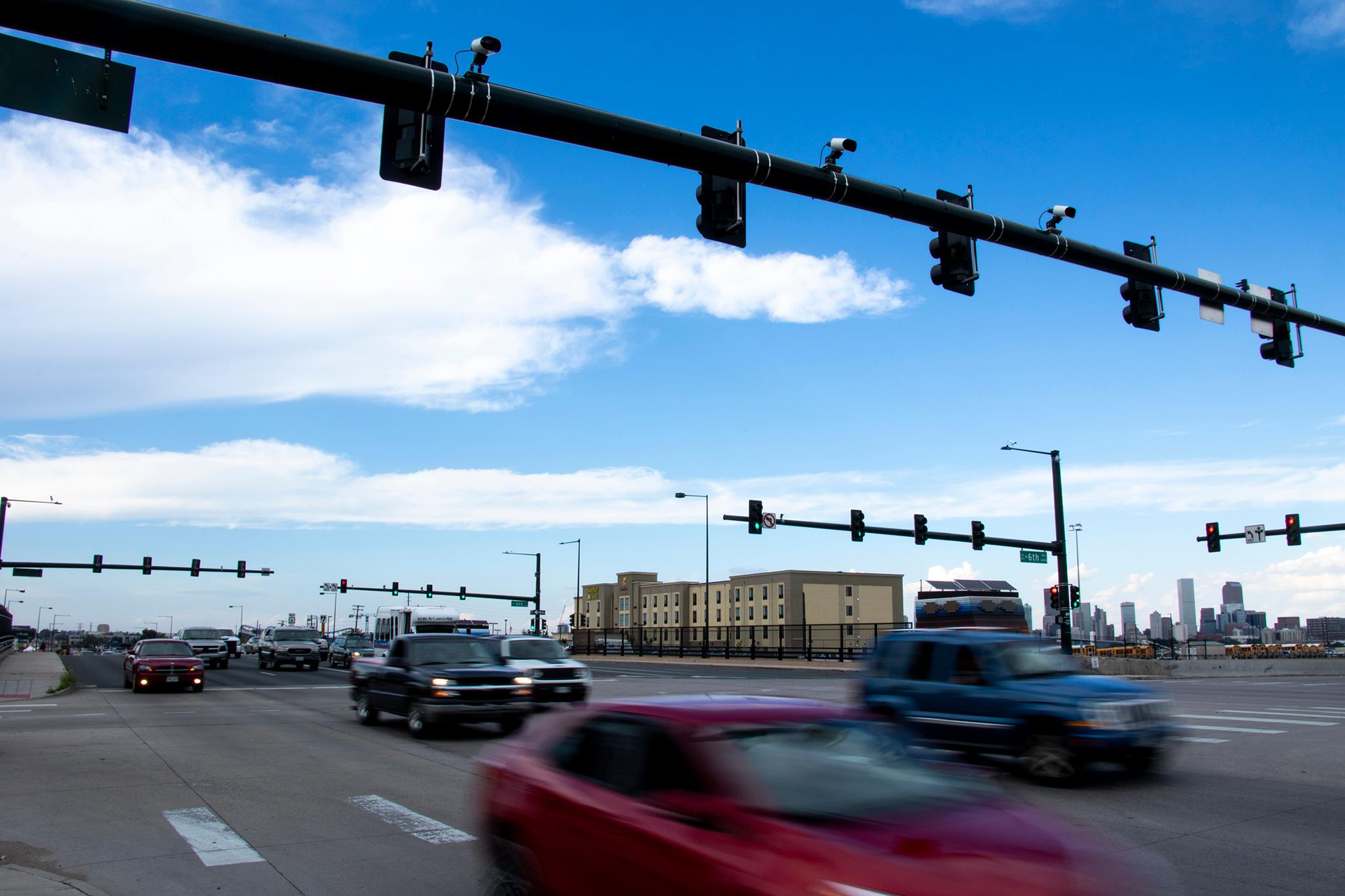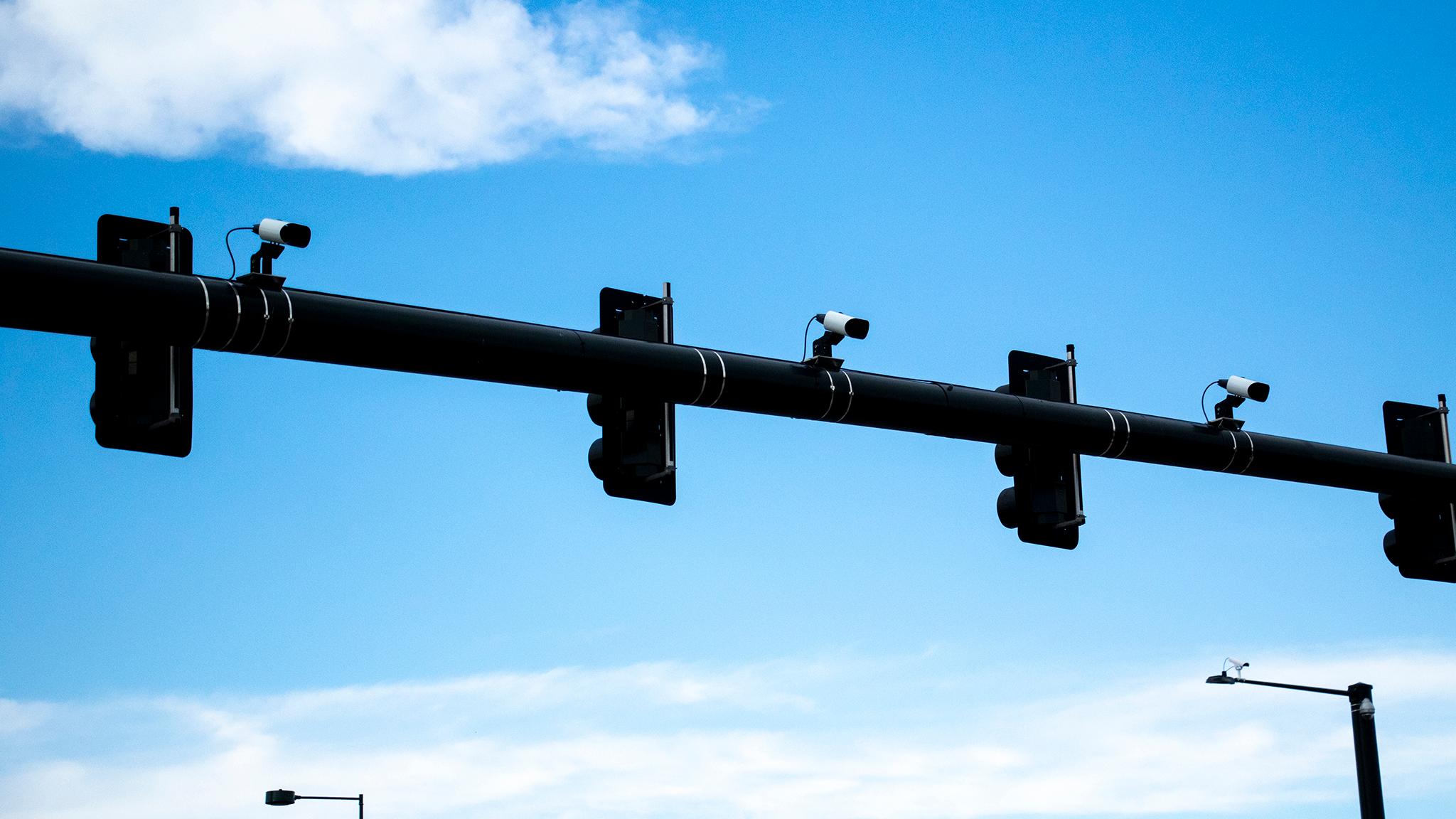Last October, the Denver Police Department installed two sets of license plate-reading cameras at Sixth Avenue and Federal Boulevard. The system scans every plate that passes through the intersection and runs them through state and federal criminal databases.
It wasn’t the first time DPD has used this kind of technology. The department operates a handful of mobile cameras in vehicles that can be placed along roadways. But the cameras installed in October were the first — and remain the only — permanent DPD fixture of this kind in the city.
The Denver Post recently reported on similar systems that are being installed by private citizens in the metro area. That data is out of reach from public records requests, but DPD data is not.
The police cameras were controversial when they were installed. Leslie Twarogowski, executive director of the Federal Boulevard Business Improvement District, said she feared the cameras’ location meant people of color and people in need of social services would be disproportionately affected. The intersection is extremely difficult for drivers on Federal to avoid, since Sixth bisects the west side of town, and it sits just south of a Denver Human Services hub.
In an interview earlier this year, Division Chief Ron Thomas told Denverite that these cameras are meant to catch vehicles that might be stolen or involved in serious matters like an amber alert or a hit-and-run.
“We certainly understand the community concern,” he said, but “it’s important to note that it was a data-driven decision.”
Both he and Chief Paul Pazen said the intersection was chosen because stolen vehicle rates were highest along that stretch at the time the installation was planned.
Here’s what the cameras see — and how they’re used.
The cameras do see a lot of suspect cars. On just one day, according to a summary the department sent Denverite, the system registered 463 database hits. One was for a stolen vehicle. Four were for stolen plates. Six were for vehicle owners with an “attempt to locate” designation, which could be for someone suspected of a crime or someone in need of a welfare check. Thirty were vehicles registered to people with misdemeanor warrants and 31 pinged the National Crime Information Center’s records. The majority of those, 391, were for cars registered to people with restrained licenses.
Thomas said people possibly driving with a revoked license “aren’t really the things we’re looking for” and that the department is not using that data to stop cars.
But DPD’s arrest data shows the department’s use is not that simple.
Denverite requested arrest and citation affidavits that indicate the plate-reading cameras were used. The department returned 37 cases between Oct. 1, 2018 and July 16, 2019. These do not represent every record in their system — affidavits written by hand or that lack the specific keyword, “LPR hit,” were not included. But the records do show many cases where the system was used.
Twenty-two of those 37 incidents resulted in felony charges. Fourteen were for stolen vehicles. The rest range from drug possession to habitual traffic offender charges.
All but one of the 15 remaining misdemeanors were categorized as traffic violations. Many were for suspended licenses.
The department provided the affidavits for 15 arrests and citations through an open records request. Most indicated that people were pulled over after officers ran their license plates, found photo IDs associated with the vehicles and then identified them visually, either by driving alongside them or when the vehicle was stopped at an intersection. About half resulted in the driver being taken into police custody.
Thomas said database hits suggesting drivers may have an outstanding warrant or a suspended license do not constitute probable cause to pull the vehicle over, since there’s no telling if the person in question is actually behind the wheel. Cars marked as stolen, on the other hand, may be stopped with just a system ping.

Among the concerns: ICE, targeting of people of color and “mission creep.”
Matt Cagle is an attorney with the ACLU of Northern California who worked on a report warning that data from systems like this could end up being shared outside of their stated purpose. U.S. Immigration and Customs Enforcement (ICE), for one, has tapped into this kind of information across the country, though much of it came from private databases.
Chief Pazen said his department’s contracts and memorandum of understanding with the system’s vendor ensured that no data from Denver’s system would be shared, especially with ICE officials.
“We double, triple and quadruple checked that,” he said.
But Cagle said the sheer quantity of data collected could cause “mission creep,” when the systems start being used to prosecute less-than-serious offenses.
“Most people probably don’t want their data being used to prosecute petty crimes,” he said, but “that’s generally the pattern we see.”
Groups like the ACLU are advocating for stronger laws about how license plate data can be used.
Twarogowski, the Federal BID leader, said she’s still conflicted about the system even though she’s glad that it’s helped close felony cases.
“I still don’t feel that everybody that travels up Federal should be recorded,” she said.
One reason for her hesitance is that the system in her neighborhood is still the only one in operation.
Jamie Torres, District 3’s newly inaugurated City Councilwoman, said the cameras “definitely hit [her] radar” when they were installed.
She said Chief Pazen told her the department would like to install more across town. The west side no longer leads the city in vehicle thefts, but “budgetary constraints” have kept them from installing more.
Catching car thieves is a big deal for Torres’ district, she said, since the lower-income residents who are more proportionally represented there don’t “rebound so quickly from those kinds of disruptions.”
Still, she added, “It’s definitely something that I want to keep an eye on.”












